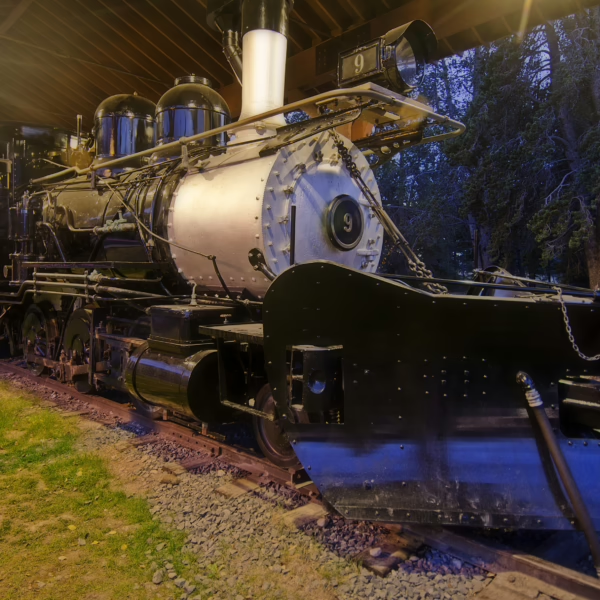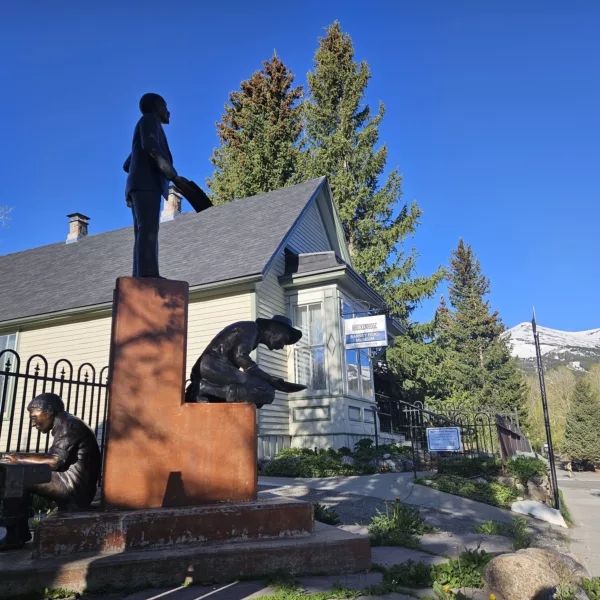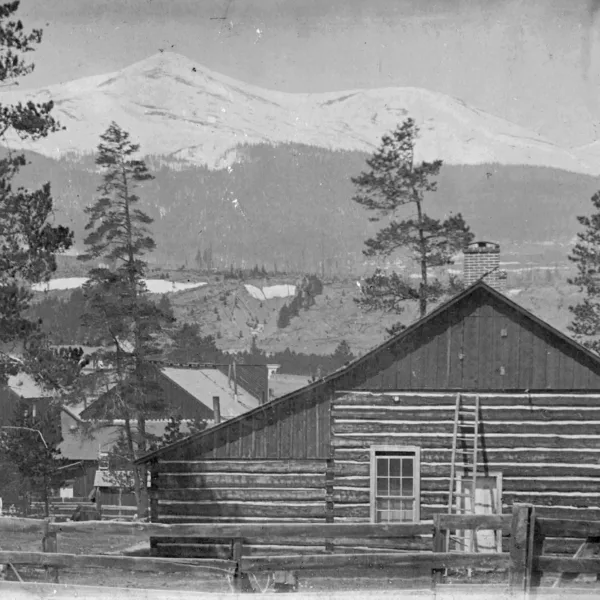Conozca la historia de los ute con motivo del Mes Nacional de la Herencia Indígena Americana
13 de noviembre de 2023 | Category: Nuestra historia colectiva

Campamento ute en el Jardín de los Dioses, Shan Kive, 1913. De la Biblioteca del Congreso.
Desde 1996, noviembre se celebra como el Mes Nacional de la Herencia Indígena Americana. Sin embargo, la herencia nativa y la historia de Estados Unidos y sus interacciones con las poblaciones nativas es increíblemente compleja. En un tiempo, 500 naciones nativas diferentes llamaban hogar a esta tierra, pero las políticas gubernamentales y las guerras han destruido algunas de esas culturas y obligado a todas las demás a adaptarse.
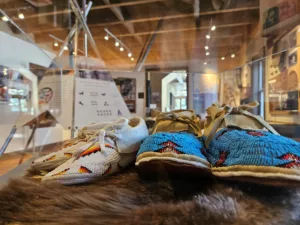
Exposición Seasons of the Nuche en el Centro de Bienvenida de Breckenridge.
El condado de Summit forma parte de las tierras ancestrales de la tribu tribu Ute. En el Centro de Bienvenida de Breckenridge, la exposición Exposición Seasons of the Nuche está actualmente en exhibición. Creada en colaboración entre los ancianos Ute y la Sociedad Histórica de Aspen, esta exposición examina la historia del pueblo Ute a través de una lente estacional. La exposición se puede visitar durante el horario del Welcome Center, de 9 a 18 h, de martes a sábado. Los ute pasaban el tiempo cazando búfalos y otros animales de caza en el valle del río Blue y aprovechaban la vegetación que crecía aquí durante el verano.
Según la historia de la creación de los ute, esta tierra ha sido su hogar desde el principio. Fueron elegidos para vivir aquí por Sinawav, el creador, y gracias a la curiosidad de Coyote, otras tribus se convirtieron en sus rivales. Para leer la historia de la creación de los ute contada por un anciano de la tribu, visite el sitio web de la sitio web de la tribu Ute del Sur.
Muchas tribus tienen sus propias historias de la creación que hablan de lugares sagrados, valores tribales y la conexión de una tribu con la tierra. Por esta misma razón, las Colinas Negras se consideran sagradas para la población lakota. También por eso las políticas gubernamentales de expulsión o reubicación fueron tan devastadoras para las tribus.
La tribu ute está formada por varias bandas, que en su día se extendían por todo Colorado y partes de Nuevo México, Arizona, Utah y Wyoming. En la actualidad, los ute ocupan tres reservas: dos en el sur de Colorado y una en Utah. Sin embargo, la forma en que navegaban y vivían en esta tierra resultó ser un recurso inestimable para todas las poblaciones que llegaron aquí después de los ute. Por ejemplo, según la tribu india de los ute del sur, lo que en el siglo XVI se conoció como el camino de los españoles, se convirtió en el camino de los ute del sur.th siglo XVI, era originalmente un camino Ute.
Las interpretaciones históricas anteriores han afirmado que las naciones tribales que vivían en todo el país no estaban bien conectadas, pero la información de las las tribus y excavaciones arqueológicas han demostrado que existía una sociedad compleja mucho antes del contacto europeo. Los senderos que conducían a grandes núcleos de población, así como la variedad de objetos encontrados en diferentes yacimientos tribales, han demostrado que el comercio entre tribus era en realidad muy común. Las naciones tribales tenían sus propios aliados, rivales y socios comerciales.
Cuando las naciones europeas entraron en contacto por primera vez con las poblaciones nativas, las interacciones fueron variadas. Para la tribu ute, el primer contacto fue con los exploradores españoles y, más tarde, con los colonos. Estas interacciones comenzaron de forma positiva con el comercio mutuo entre las naciones. Aunque hay opiniones encontradas sobre si los caballos eran anteriores al contacto europeo, se convirtieron en una parte influyente de la cultura ute tras la llegada de los españoles. Según la historia de los ute, fueron una de las primeras naciones nativas, si no la primera, en utilizar el caballo. Esto aumentó su capacidad para desplazarse por sus tierras en grandes grupos y sus posibilidades de caza. A medida que la cultura ute se adaptaba y aumentaba la importancia de los caballos, también lo hacían las interacciones entre los colonos españoles y las naciones nativas. Como los colonos seguían invadiendo las tierras de los ute, muchas de las interacciones se volvieron hostiles. Esto culminó en el primer tratado de paz entre el pueblo Ute y los oficiales españoles en 1670. Casi 100 años después, hacia 1760, los ute concedieron a España el derecho a comerciar a lo largo del río Gunnison, precursor de las grandes rutas comerciales que estaban por llegar. En 1811, los ute empezaron a encontrarse con cazadores de pieles en sus tierras y, para cuando se estableció el Camino de Santa Fé en 1821, el paso de grandes cantidades de comercio por territorio ute era algo habitual. En las décadas siguientes, el comercio se vio favorecido por el establecimiento de fuertes en el territorio ute, como Fort Uncompahgre, Bent's Fort y Fort Pueblo.

Un grupo de hombres y mujeres Ute en Colorado, 1893. De la Biblioteca del Congreso.
Con el fin de la guerra mexicano-estadounidense en 1849, los ute primer tratado con el gobierno estadounidense. En el tratado, los ute acordaron reconocer la soberanía de la nación estadounidense, permitir el establecimiento de puestos militares avanzados y acordaron permanecer dentro de los límites territoriales establecidos por el gobierno estadounidense, al tiempo que permitían a la población de Estados Unidos el libre paso por las tierras de los ute. Sin embargo, 1849 se considera el inicio de las guerras entre Estados Unidos y los ute. Estas guerras consistieron en una serie de hostilidades entre diferentes bandas ute y colonos estadounidenses a lo largo de una amplia extensión de tierra que incluía Colorado y Utah. Aunque se establecieron numerosos tratados durante esta época, las guerras no concluyeron oficialmente hasta 1923.
Durante esta época, la historia de Colorado hizo aún más complejas las interacciones con el pueblo ute. La Fiebre del Oro en 1859 trajo una población mucho mayor al estado. La afluencia de población también trajo una afluencia de enfermedades. Entre 1859 y 1879 la población ute descendió de 8.000 a 2.000 personas. El establecimiento de Colorado como territorio (1861) y estado (1876) no hizo sino avivar aún más las interacciones entre el pueblo ute y los colonos. En 1868, la tribu ute fue confinada al tercio occidental del territorio de Coloradoy sólo unos años más tarde, en 1873, los Ute se vieron obligados a ceder una cuarta parte de sus tierras restantes tras el hallazgo de oro y plata en las montañas de San Juan. Como parte del acuerdo -no se consideró un tratado porque el gobierno estadounidense no reconocía entonces a las tribus como naciones soberanas-, el presidente de la Junta de Asuntos Indios, Felix Brunot, debía ayudar al jefe Ouray a encontrar a su hijo, al tiempo que concedía a los utes derechos de caza en la zona y se comprometía a pagar anualmente a la tribu.
En aquella época, la política estadounidense hacia las naciones nativas había cambiado en gran medida hacia la asimilación. La esperanza era que los miembros de las tribus renunciaran a sus estilos de vida tradicionales para convertirse en agricultores y colonizar tierras. Uno de los mayores partidarios de esta idea fue agente indio Nathan Meeker. Meeker presionó a los ute para que se asentaran y se produjeron varios conflictos. En septiembre de 1879, Meeker solicitó la ayuda de tropas federales para asegurar su posición. Al ver esto como una amenaza, los ute se rebelaron, mataron a 11 personas, incluido Meeker, y tomaron cautiva a su familia. El gobierno quiso responsabilizar a los ute del ataque y pidió a Ouray que llevara a 12 hombres a Washington, D.C., para ser juzgados. Aunque los miembros de la tribu fueron absueltos, éste fue el catalizador que finalmente hizo que las bandas de White River y Uncompahgre fueran expulsadas de Colorado en un viaje de 350 millas hasta su reserva en Utah escoltadas por 1.000 soldados. Los Utes del Sur permanecieron en Colorado.
Sin embargo, todo esto es sólo una pequeña parte de la historia del pueblo ute. La belleza de su pueblo, su cultura y sus tradiciones sigue viva. Los conflictos sobre el pasado y las formas de vida siguen vivos. Hoy podemos ver el legado de antiguas políticas como la asimilación de muchas maneras. El hecho de que muchas lenguas nativas se estén extinguiendo es un resultado directo. La pérdida de identidad cultural causada por los internados y otras políticas aún perdura. Pero lo más importante es que la población nativa de Estados Unidos sigue aquí. La mejor manera de saber más sobre el pueblo ute es conectar directamente con la tribu.
He aquí algunos recursos para profundizar en el tema: el Sitio web de la tribu india Ute, Sitio web de la tribu india Ute del Sur, Sitio web de la tribu Ute Mountain Ute, Museo Indio Ute en Montrose, y el Centro Cultural y Museo Ute del Sur en Ignacio.
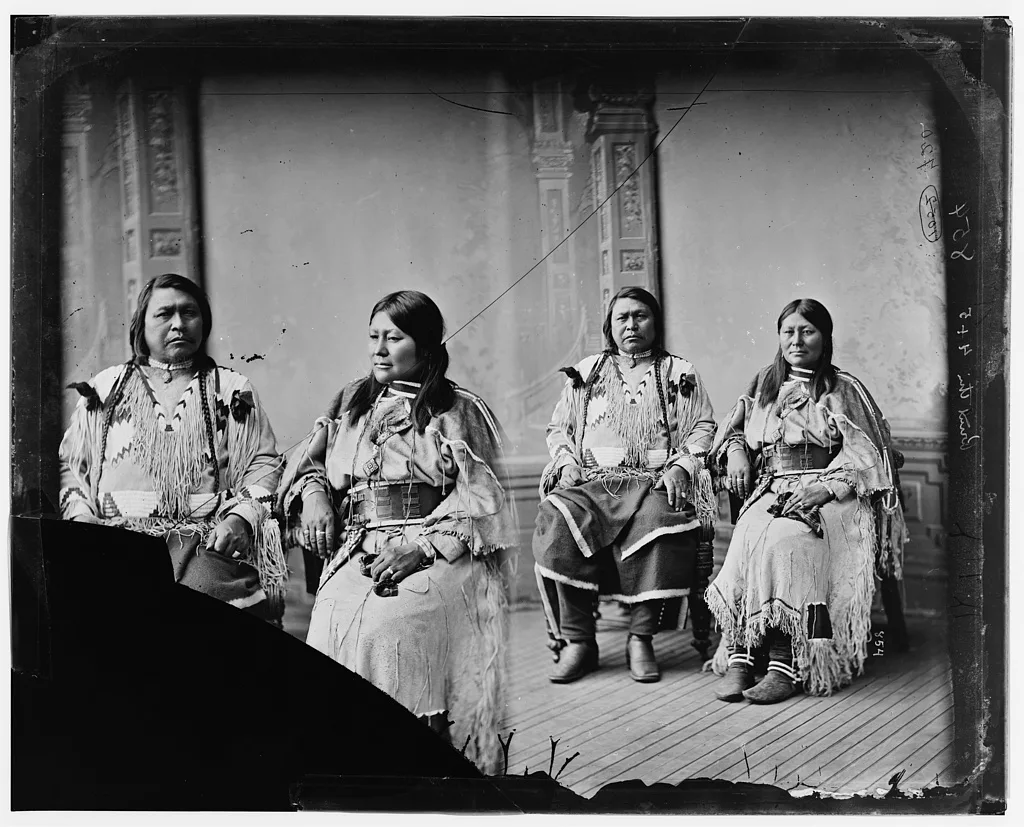
El jefe Ouray y su esposa, Chipeta. Hacia 1880. Colección de fotografías Brady-Handy, Biblioteca del Congreso, División de Impresiones y Fotografías.

